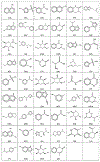Benchmark Sets for Binding Hot Spot Identification in Fragment-Based Ligand Discovery
- PMID: 33291870
- PMCID: PMC8200320
- DOI: 10.1021/acs.jcim.0c00877
Benchmark Sets for Binding Hot Spot Identification in Fragment-Based Ligand Discovery
Abstract
Binding hot spots are regions of proteins that, due to their potentially high contribution to the binding free energy, have high propensity to bind small molecules. We present benchmark sets for testing computational methods for the identification of binding hot spots with emphasis on fragment-based ligand discovery. Each protein structure in the set binds a fragment, which is extended into larger ligands in other structures without substantial change in its binding mode. Structures of the same proteins without any bound ligand are also collected to form an unbound benchmark. We also discuss a set developed by Astex Pharmaceuticals for the validation of hot and warm spots for fragment binding. The set is based on the assumption that a fragment that occurs in diverse ligands in the same subpocket identifies a binding hot spot. Since this set includes only ligand-bound proteins, we added a set with unbound structures. All four sets were tested using FTMap, a computational analogue of fragment screening experiments to form a baseline for testing other prediction methods, and differences among the sets are discussed.
Conflict of interest statement
Conflict of Interest Disclosure:
Acpharis Inc. offers commercial licenses to ATLAS, a software product in function similar to FTMap. Dima Kozakov and Sandor Vajda owns stock in the company. However, the FTMap program and the use of the FTMap server are free for academic and governmental use.
Figures






Similar articles
-
Expanding FTMap for Fragment-Based Identification of Pharmacophore Regions in Ligand Binding Sites.J Chem Inf Model. 2024 Mar 25;64(6):2084-2100. doi: 10.1021/acs.jcim.3c01969. Epub 2024 Mar 8. J Chem Inf Model. 2024. PMID: 38456842 Free PMC article.
-
Relationship between hot spot residues and ligand binding hot spots in protein-protein interfaces.J Chem Inf Model. 2012 Aug 27;52(8):2236-44. doi: 10.1021/ci300175u. Epub 2012 Jul 24. J Chem Inf Model. 2012. PMID: 22770357 Free PMC article.
-
Hot spot analysis for driving the development of hits into leads in fragment-based drug discovery.J Chem Inf Model. 2012 Jan 23;52(1):199-209. doi: 10.1021/ci200468p. Epub 2011 Dec 15. J Chem Inf Model. 2012. PMID: 22145575 Free PMC article.
-
Lessons from Hot Spot Analysis for Fragment-Based Drug Discovery.Trends Pharmacol Sci. 2015 Nov;36(11):724-736. doi: 10.1016/j.tips.2015.08.003. Epub 2015 Nov 1. Trends Pharmacol Sci. 2015. PMID: 26538314 Free PMC article. Review.
-
Mapping the binding sites of challenging drug targets.Curr Opin Struct Biol. 2022 Aug;75:102396. doi: 10.1016/j.sbi.2022.102396. Epub 2022 May 27. Curr Opin Struct Biol. 2022. PMID: 35636004 Free PMC article. Review.
Cited by
-
Conservation of Hot Spots and Ligand Binding Sites in Protein Models by AlphaFold2.J Chem Inf Model. 2024 Feb 12;64(3):960-973. doi: 10.1021/acs.jcim.3c01761. Epub 2024 Jan 22. J Chem Inf Model. 2024. PMID: 38253327 Free PMC article.
-
Expanding FTMap for Fragment-Based Identification of Pharmacophore Regions in Ligand Binding Sites.J Chem Inf Model. 2024 Mar 25;64(6):2084-2100. doi: 10.1021/acs.jcim.3c01969. Epub 2024 Mar 8. J Chem Inf Model. 2024. PMID: 38456842 Free PMC article.
-
Fragment-to-Lead Medicinal Chemistry Publications in 2020.J Med Chem. 2022 Jan 13;65(1):84-99. doi: 10.1021/acs.jmedchem.1c01803. Epub 2021 Dec 20. J Med Chem. 2022. PMID: 34928151 Free PMC article. Review.
-
Common recognition topology of mex transporters of Pseudomonas aeruginosa revealed by molecular modelling.Front Pharmacol. 2022 Nov 11;13:1021916. doi: 10.3389/fphar.2022.1021916. eCollection 2022. Front Pharmacol. 2022. PMID: 36438787 Free PMC article.
-
API Development Increases Access to Shared Computing Resources at Boston University.J Softw Eng Appl. 2022 Jun;15(6):197-207. doi: 10.4236/jsea.2022.156011. Epub 2022 Jun 29. J Softw Eng Appl. 2022. PMID: 36568682 Free PMC article.
References
-
- Clackson T; Wells JA, A hot spot of binding energy in a hormone-receptor interface. Science 1995, 267, 383–386. - PubMed
-
- Thanos CD; Randal M; Wells JA, Potent small-molecule binding to a dynamic hot spot on IL-2. Journal of the American Chemical Society 2003, 125, 15280–15281. - PubMed
-
- Allen KN; Bellamacina CR; Ding XC; Jeffery CJ; Mattos C; Petsko GA; Ringe D, An experimental approach to mapping the binding surfaces of crystalline proteins. J. Phys. Chem 1996, 100, 2605–2611.
-
- Mattos C; Ringe D, Locating and characterizing binding sites on proteins. Nat. Biotechnol 1996, 14, 595–599. - PubMed
-
- English AC; Groom CR; Hubbard RE, Experimental and computational mapping of the binding surface of a crystalline protein. Protein Eng. 2001, 14, 47–59. - PubMed
Publication types
MeSH terms
Substances
Grants and funding
LinkOut - more resources
Full Text Sources

